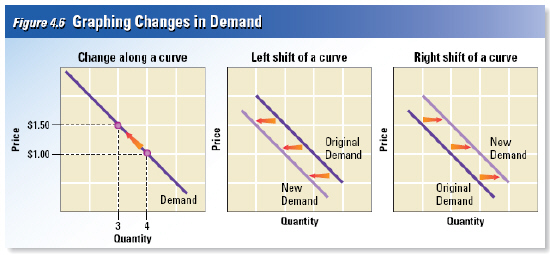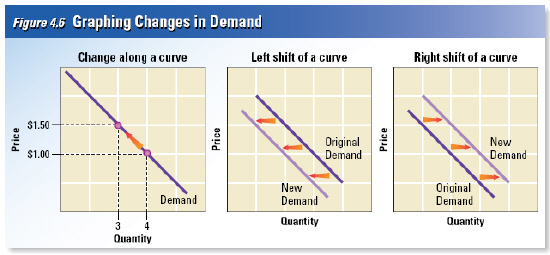|
|
|
|
|
|
1.
|
Examine the graphic above. It
shows the goals for this lesson. On the right, explain what you expect to learn in this lesson. Also,
pay attention to the vocabulary words and look for them as you progress through the lesson. You will
be tested on them later
|
|
|
The market demand schedule for pizza in
Figure 4.3 would
appear to give the
pizzeria owner all the information she
needs to set the prices for her menu.
All she has to do is look at the list, pick the price and quantity combination that will earn her the
highest profit, and start baking.
Other factors, however, might have an
effect. What would
happen if the day after
she printed a menu, the government
announced that tomato sauce had a
natural
chemical that strengthened the immune
system? Demand for pizza at all prices
would
climb.
| When we counted the number of pizza
slices that would sell as the price
went up
or down, we assumed that
nothing besides the price of pizza
would change. Economists
refer
to this assumption as ceteris
paribus, the Latin phrase for “all
other things held
constant ” The
demand schedule took only
changes in price into account. It
did not
take the news reports into
account, or any one of thousands
of other factors that change
from
day to day. In this section, you will
learn how economists consider the
impact of these
other changes on
the demand for goods like pizza. | | |
|
|
|
2.
|
What does the demand schedula
take into account when assertaining what the demand for pizza will be?
a. | price | c. | all business expenses | b. | the cost of the
ingredients | d. | customer
income |
|
|
|
3.
|
What does ceteris paribus (all things being equal)
mean?
a. | People who speak latin usually like
pizza | c. | the demand for pizza is equal (the
same) no matter what the price. | b. | the price of pizza is equal no matter what the
demand. | d. | ignore everything except price in determining
demand |
|
|
|
 | Changes in Demand
A demand curve is accurate only as long as
there are no
changes other than price that
could affect the consumer’s decision. In
other words, a
demand curve is accurate
only as long as the ceteris paribus assumption is true. When the price changes, we move along the
curve to a different
quantity demanded. For example, in the
graph of Ashley’s demand for
slices of
pizza, an increase in the price from $1.00
per slice to $1.50 will make
Ashley’s
quantity demanded fall from four slices to
three slices per day. This movement
along
the demand curve is referred to as a decrease in the quantity demanded. By
the
same reasoning, a decrease in the price of
pizza would lead to an increase in
the
quantity demanded.
| When we
drop the ceteris paribus
rule
and allow other factors to change, we no
longer move along the demand
curve.
Instead, the entire demand curve shifts. A
shift in the demand curve means that
at
every price, consumers buy a different
quantity than before. This shift of the
entire
curve is what economists refer to as a
change in demand.
Suppose, for example, that
Ashley’s
town is hit by a heat wave, and Ashley no
longer feels as hungry for pizza. She
will
demand fewer slices at every price. The
middle graph in Figure 4.6 shows her
original
demand curve and her new
demand curve, adjusted for hot weather. | | |
|
|
|
4.
|
A demand curve is accurate only
as long as the ceteris paribus
assumption is true.What does this mean?
a. | price as well as other factors
influence demand | c. | a demand curve is
accurate as long as price is not influencing demand. | b. | demand is not influenced by any factors other than the
demand of the consumer | d. | a demand curve is accurate as long
as price is the only factor changing demand. |
|
|
|
5.
|
What would cause a
decrease in the quantity
demanded.by Ashley?
a. | a rise in
price | c. | a price that remains the
same | b. | a lowering of price |
|
|
|
6.
|
What would cause an
increase in the quantity
demanded.by Ashley?
a. | a rise in
price | c. | price that remains the
same | b. | a lowering of price |
|
|
|
7.
|
What happens when you allow
factors other than price to influence demand?
a. | The entire demand curve shifts to
the right or left | c. | The demand curve
becomes straight | b. | The demend curve bends | d. | The demand curve does not move |
|
|
|
8.
|
Ashley’s pizza restaurant
is right next to the San Diego Padre’s baseball park. During the game they flash a picture of
Ashley’s restuarant and a big pizza on the jumbotron. After the game Ashleys restaurant is
flooded with new customers. What happens to her demend curve?
a. | it changes to reflect
price | c. | it shifts to the
left | b. | it does not move | d. | it ships to the right |
|
|
|
9.
|
A change in quantity demanded
caused by a change in price is shown as a movement along a demand curve. The curve does not shift. When factors other than
price cause demand to fall, the demand curve
a. | remains
static | c. | shifts to the left
| b. | demand can only be effected by
price | d. | shifts to the
right |
|
|
|
 | | What Causes a Shift?
As you have read, a change in the price of a
good does not cause the demand
curve to
shift. The effects of changes in price are
already built into the demand
curve.
However, several other factors can cause
demand for a good to change. These
changes
can lead to a change in demand
rather than simply a change in the
quantity
demanded.
Income
A consumer’s income affects his or her
demand for
most goods. Most items that we
purchase are normal goods, goods that
consumers demand
more of when their
incomes increase. In other words, an increase in Ashley’s income from $50
per week to
$75 per week will cause her to buy more of a
normal good at every price level. If
we were
to draw a new demand schedule for Ashley,
| it would show a greater demand for slices of
pizza at
every price. Plotting the new
schedule on a graph would produce a curve
to the right of
Ashley’s original curve. For
each of the prices on the vertical axis, the
quantity
demanded would be greater. This
shift to the right of the curve is called
an
increase in demand. A
fall in income would
cause the demand curve to shift left. This
shift is called a decrease
in demand.
There are also other goods called inferior
goods. They are called
inferior goods
because an increase in income causes
demand for these goods to fall.
Inferior
goods are goods that you would buy in
smaller quantities, or not at all, if
your
income were to rise and you could afford
something better. Possible examples
of
inferior goods include macaroni and
cheese, generic cereals, and used
cars. | | | |
|
|
|
10.
|
If Ashley’s income rises
what will be the likely effect on demand.
a. | She will be reluctant to increase
her demand because prices rise | c. | He demand will increase at $1.00 per slice but not $1.50 per
slice | b. | She will increase her damand no matter what the
price | d. | Her demand will decrease at $150 per slice but not $1.00
per slice |
|
|
|
11.
|
What is a normal good?
a. | A good in which demand increases
with an increase in income | c. | A good that is not effected by price | b. | A good in which demend decreases with an increase in
income | d. | A good that is not effected by the income of the
consumer |
|
|
|
12.
|
What are inferior goods?
a. | goods that fall in demand with a
fall in income | c. | goods in which
demand does not change as a result of a change in income | b. | goods that fall in demand with an increase in
income | d. | goods the increase in demand with an increase in
income |
|
|
|
What Causes a
Shift?
Consumer Expectations
Our expectations about the future can
affect our demand
for certain goods today.
Suppose that you have had your eye on a
new bicycle for several
months. One day
you walk in the store to look at the bike,
and the salesperson mentions that
the store
will be raising the price in one week. Now
that you expect a higher price in the
near
future, you are more likely to buy the bike
today. In other words, the expectation of
a
higher price in the future has caused your
immediate demand to
increase.
| If, on the other hand, the salesperson
were to tell you that the bike will
be on sale
next week, your immediate demand for the
bicycle would fall to zero. You
would
rather wait until next week to buy the bike
at a lower price.
The current demand
for a good is positively
related to its expected future price. If
you expect the price to rise,
your current
demand will rise, which means you will
buy the good sooner. If you expect
the
price to drop, your current demand will
fall and you will wait for the lower
price. | | |
|
|
|
13.
|
How does expectation effect
demand? (pick 2)
|
|
|
What Causes a
Shift?
Population
Changes in the size of the population will also affect the
demand for most products. For example, a growing population needs to be housed and fed. Therefore, a
rise in population will increase demand for houses, food, and many other goods and services.
Population trends can have a particularly strong effect on certain goods. For example, when
American soldiers returned from World War II in the mid- to late 1940s, record numbers of them
married and started families. This trend led to the “baby boom,” a jump in the birthrate
from the mid-1940s through 1964. Initially, the baby boom led to higher demand | for baby
clothes, baby food, and books on baby care. In the 1950s and 1960s, towns had to build thousands of
new schools. Later, universities opened new classrooms, dormitories, and even whole new campuses to
make room for the flood of new students. The baby boomers have now begun to retire. Over the next few
decades the market will face rising demand for the goods and services that are desired by senior
citizens, including medical care, recreational vehicles, and homes in the
Sunbelt. | | |
|
|
|
14.
|
As Japan’s population
ages, what will be the overall effect on the economy?
a. | likely to falter because fewer
people are working to produce the goods and services required by the
elderly | c. | likely to falter
becacause youg people are by nature lazy and do not want to work | b. | likely to improve because more jobs are available for
young people as the elderly retire | d. | likely to improve because people are living
longer |
|
|
|
15.
|
Japan has a serious shortage of
young people. The population aging and fewer babies are being born. What effect is this likely to
have on the consumption of domestic goods and services? (pick 2)
|
|
|
What Causes a
Shift?
Consumer Tastes and
Advertising
Who can explain why
bell-bottom blue
jeans were everywhere one year and rarely
seen the next? Is it the result of
clever
advertising campaigns, social trends, the
influence of television shows, or
some
combination of these factors? Although
economists cannot always isolate the
reasons why
some fads begin, advertising
and publicity often play an important
role.
| Changes in tastes and preferences cannot
be explained by changes in income
or population or worries about future price increases. Advertising is considered a factor that
shifts demand curves because it plays an important role in many trends. Companies spend money on
advertising because they hope that it will increase the demand for the goods they sell. Considering
the growing sums of money spent on advertising in the United States each year, companies must feel
that this investment is paying off.
| | |
|
|
|
16.
|
How did the
“hippie” generation of the 1970’s effect the demand for VW
Busses?
a. | demand
fell | c. | demand remained about the
same | b. | demand increased | d. | there was no demand at all for VW
busses |
|
|
|
17.
|
Colorado recently leagalized
the use of marajuana. What effect did this have on the demand for social services such as medical,
food stamps and shelter?
a. | it fell because most people who use
marajuana live on the streets | c. | it neither increased or decreased because people who are “high”
usually do not demand anything | b. | it increased because many unproductive young people flooded the
state | d. | it increased because most of the new users were the
elderly |
|
|
|
Prices of Related
Goods
The demand curve for one
good can be
affected by a change in the demand for
another good. There are two types
of
related goods that interact this way:
complements and
substitutes.
•
Complements are two goods that are
bought and used together.
•
Substitutes are goods used in place of one
another.
When we consider the demand
for skis,
ski boots are considered a complement. An
increase in the price of ski boots will
cause
people to buy fewer boots. Because skis are
useless without boots, the demand for
skis
will fall at all prices—after all, why buy
new skis if you can’t afford the
ski boots
you need to ski safely?
Now consider the effect on the demand
for skis when
the price of snowboards rises.
Snowboards are a substitute for skis,
because consumers will
often buy one or
the other, but not both. A rise in the price
of snowboards will cause people
to buy
fewer snowboards, and therefore people
will buy more pairs of new skis at
every
price. Likewise, a fall in the price of snowboards will lead consumers to buy fewer
skis
at all price levels.
|

Ski boots and skis
are two goods that are complements.

| | |
|
|
|
18.
|
Bicycles and
helmets
a. | compliments | b. | substitutes |
|
|
|
19.
|
automobiles and
motorcycles
a. | compliments | b. | substitutes |
|
|
|
20.
|
potato chips and
nachos
a. | compliments | b. | substitutes |
|
|
|
21.
|
computers and
tablets
a. | compliments | b. | substitutes |
|
|
|
22.
|
dinner and
wine
a. | compliments | b. | substitutes |
|
|
|
a. | inferior
good | d. | complements | b. | ceteris
paribus | e. | normal
good | c. | substitutes |
|
|
|
23.
|
a good that consumers demand more of when their incomes
increase
|
|
|
24.
|
two goods that are bought and used
together
|
|
|
25.
|
a Latin phrase that means ? “all other things held
constant? ”
|
|
|
26.
|
goods used in place of one another
|
|
|
27.
|
a good that consumers demand less of when their incomes
increase
|